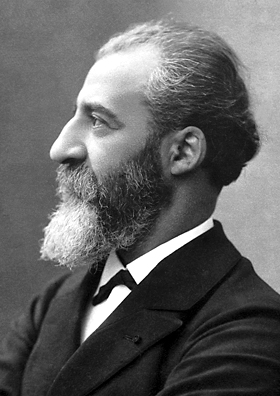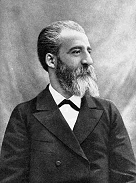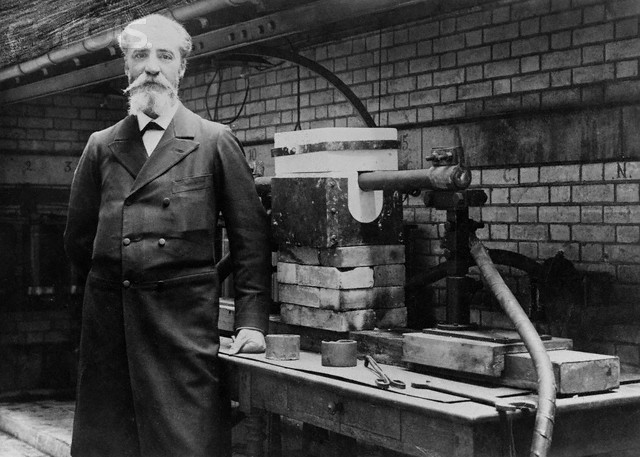<Back to Index>
- Chemist Ferdinand Frederick Henri Moissan, 1852
- Painter Alexandre Cabanel, 1823
- German Revolutionary Friedrich Franz Karl Hecker, 1811
PAGE SPONSOR


Ferdinand Frederick Henri Moissan (September 28, 1852, Paris – February 20, 1907) was a French chemist who won the 1906 Nobel Prize in Chemistry for his work in isolating fluorine from its compounds.
The family Moissan originated from Toulouse and moved to Paris, where Moissan was born September 28, 1852, the son of a lesser officer of the eastern railway company and a seamstress. In 1864 they moved to Meaux, where he attended the local school. In 1870 he left the school without the "grade universitaire" necessary to attend the university. He started working at a chemist in Paris where he was able to save a person intoxicated with arsenic. He decided to study chemistry and started first at the laboratory of Edmond Frémy and later at that of Pierre Paul Dehérain. Dehérain argued him into an academic career. The baccalauréat which was necessary to study at the university Moissan obtained in 1874 after a failed attempt. During his time in Paris he became friend of the chemist Alexandre Léon Étard and botanist Vasque.
He published his first scientific paper about the carbon dioxide and oxygen metabolism in plants with Dehérain in 1874. He left plant physiology and turned towards inorganic chemistry and his research on pyrophoric iron was well received by the two most prominent French inorganic chemists of that time, Henri Etienne Sainte-Claire Deville and Debray. Afer Moissan received his Ph.D. in 1880, his friend Landrine offered him a position at an analytic laboratory. His marriage to Léonie Lugan took place in 1882. They had a son in 1885. During the 1880s Moissan was focused on fluorine chemistry and especially the production of fluorine itself. He had no laboratory of his own, but used several laboratories, for example that of Charles Friedel. There he had access to a strong battery consisting of 90 Bunsen cells which made it possible to observe a gas produced by the electrolysis of moltenarsenic trichloride; the gas was reabsorbed by the arsenic trichloride. The electrolysis of hydrogen fluoride yielded fluorine on June 26, 1886. The French academy of science sent three representatives, Marcellin Berthelot, Henri Debray and Edmond Frémy, to prove the results. Moissan was unable to reproduce his results, due to the fact that the hydrogen fluoride did not contain any traces of potassium fluoride, as in the previous experiment. After resolving the problem and demonstrating the production of fluorine several times, he was awarded a prize of 10,000 francs. The following years till 1891 he focused on the research of fluorine chemistry. He discovered numerous fluorine compounds, for example together with Paul Lebeau SF6 in 1901. His research in the production of boron and artificial diamonds and the development of an electrically heated oven which was capable to reach 3500°C using 2200 Ampere at 80 Volt followed until 1900.
His newly developed arc furnace opened the road to obtain borides and carbides of numerous elements, which was another research area of Moissan. The existence of the element fluorine had been well known for many years, but all attempts to isolate it had failed – and some experimenters had died in the attempt. Moissan eventually succeeded in preparing fluorine in 1886 by the electrolysis of a solution of potassium hydrogen difluoride (KHF2) in liquid hydrogen fluoride (HF). The mixture was needed because hydrogen fluoride is a non - conductor. The device was built with platinum / iridium electrodes in a platinum holder and the apparatus was cooled to −50 °C. The result was to completely isolate the hydrogen produced from the negative electrode from the fluorine produced at the positive one. This is essentially still the way fluorine is produced today. For this achievement, he was awarded the Nobel Prize in 1906.
Moissan went on to study fluorine chemistry in great detail, contributed to the development of the electric arc furnace and attempted to use pressure to synthesize diamonds from the more common form of carbon. In 1893, Moissan began studying fragments of a meteorite found in Meteor Crater near Diablo Canyon in Arizona.
In these fragments he discovered minute quantities of a new mineral
and, after extensive research, Moissan concluded that this mineral was
made of silicon carbide. In 1905, this mineral was named Moissanite, in his honor.
He died suddenly in Paris in February 1907, shortly after his return from receiving the Nobel Prize in Stockholm. His death was attributed to an acute appendicitis. It is not known whether his experiments with fluorine contributed to his early death like others in his area of study.
